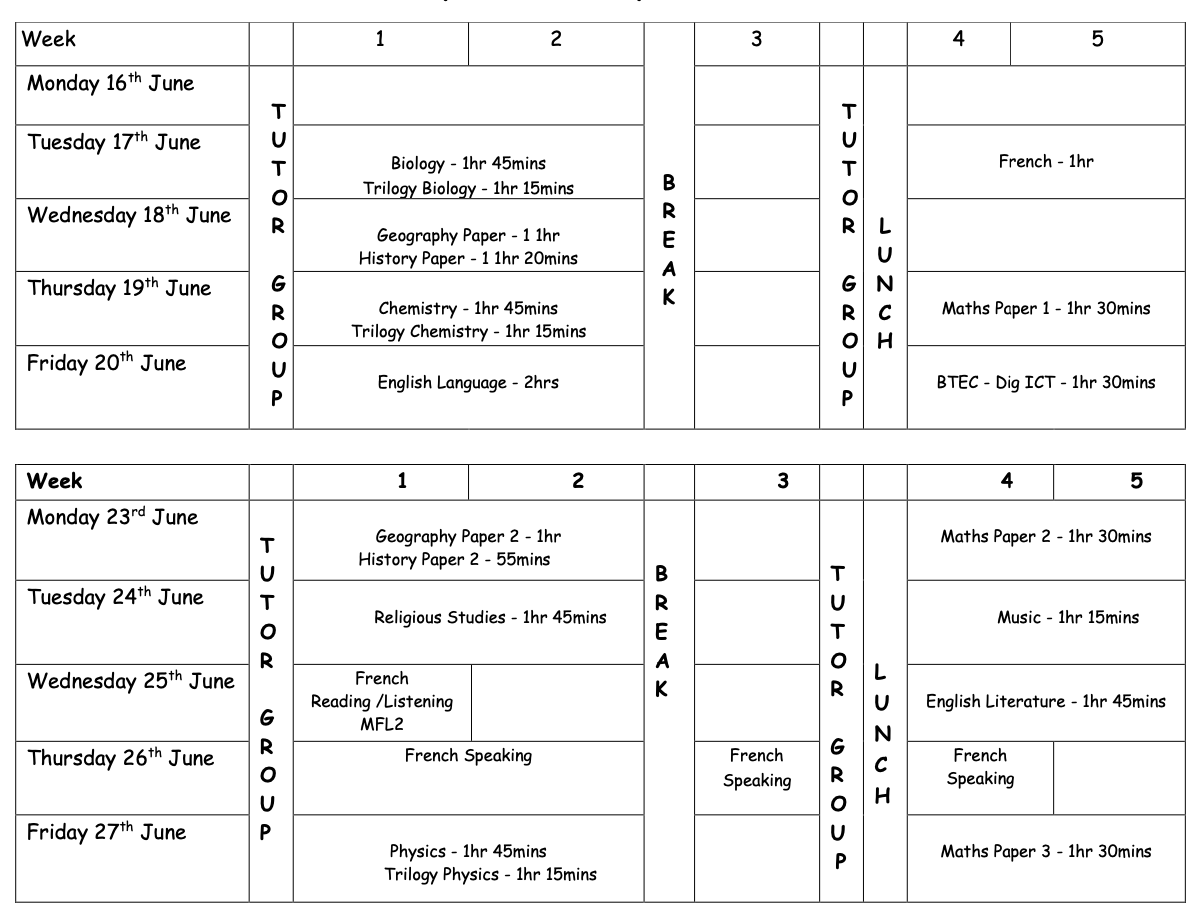Year 10 Hub
Welcome to the Year 10 Hub – your central source for all key information related to Year 10. This page is designed to be clear, easy to navigate, and regularly updated with the latest details.
Key Information
Please note the upcoming Year 10 Parents' Evening will take place on 17th July from 3:30–6:00pm.
Year 10 Internal Assessment Information
All assessments will take place in the Sports Hall or Exam Suite between Tuesday 17th June and Friday 27th June. Students must register using the Thumbprint system before each assessment.
Thorough revision is essential, and students are expected to demonstrate excellent behaviour at all times. They should listen carefully to all instructions, wear the correct uniform, and arrive on time for every assessment.
Seating plans will be displayed on the door of the Sports Hall and on the Head of Year notice boards. Students must check these plans to identify their assessment room and seat number. For whole-cohort assessments, the same seat will be used each time. For smaller assessments, a seating plan will be displayed on the Exam Suite door each morning.
Please find the Internal Assessment Timetable below:

Revision Lists
Religious Studies Revision List
Christianity Beliefs
Christianity Practices
Religion and Life
Religion, Peace and Conflict
All students have been provided with a revision guide free of charge. This should be taken home and used as your primary tool for revision.
Health and Fitness Revision List
- Blood vessels- structure and function.
- Cardiovascular system.
- Skeletal system.
- Muscular system and types of muscle.
- Aerobic and anaerobic energy systems.
- Components of fitness.
- Testing the components of fitness.
- Short term effects of exercise.
- Long term effects of exercise.
- The principles of training.
- PAR-Q surveys- what are they? How do they work?
- Diet and Nutrition
- Benefits of a warm up and cool down.
English Revision List
Year 10 English Language – Component 2 Revision List
- Skim and scan for key information in non-fiction texts
- Signpost your reading of an extract
- Identify writer’s purpose and audience
- Recognise and explain tone and viewpoint
- Spot and comment on language features (e.g. emotive language, repetition)
- Use quotations effectively in reading answers
- Compare ideas and attitudes across two texts
- Compare writers’ methods (language and tone)
- Summarise key differences or similarities between texts
- Write in paragraphs with clear topic sentences
- Adapt tone and style for different audiences
- Use rhetorical devices (rule of 3, questions, emotive language)
- Plan writing using a clear structure (intro, main points, conclusion)
- Use a range of sentence types and lengths
- Use accurate spelling, punctuation and grammar
- Know features of a letter (addresses, formal tone, sign-off)
- Know features of a speech (direct address, rhetorical questions)
- Know features of an article (headline, introduction, persuasive tone)
- Know features of a leaflet (headings, bullet points, layout)
- Know features of an essay (clear argument, formal tone)
- Time management – complete all questions within 2 hours
- Practise unseen reading extracts (19th & 21st century)
- Edit and proofread writing for errors
- Include personal voice or anecdotes where suitable
- Use ambitious vocabulary and figurative language effectively
Year 10 English Literature – Component 2 (A Christmas Carol & Unseen Poetry)
A Christmas Carol
- Understand the plot and key events in each stave
- Know main characters (Scrooge, Marley, Cratchit, Fred, Ghosts)
- Explore Scrooge’s character development across the novella
- Understand the social and historical context (Victorian poverty, charity, class)
- Learn key themes: redemption, social responsibility, family, time, Christmas
- Analyse Dickens’ use of language
- Identify and explain writer’s purpose and message
- Learn key quotes for major characters and themes
- Understand structure: narrative arc, role of the narrator
- Practise responding to extract-based essay questions
- Link extracts to the wider novella
- Use a 2-part thesis statement (general sentence about the novella, general sentence in relation to the question, authorial intent)
- Use context appropriately and link it to writer’s message
- Time management – complete the essay in approx. 45 minutes
Unseen Poetry
- Read and understand a poem independently
- Identify and explain poetic techniques (similes, personification, enjambment, etc.)
- Comment on tone and mood
- Analyse how structure and form affect meaning
- Understand the poem’s message or theme
- Explore the poet’s attitude and viewpoint
- Use subject terminology accurately
- Support ideas with short, relevant quotations
- Write a clear, focused response to a single unseen poem
- Compare two unseen poems effectively
- Use comparative phrases (similarly, in contrast, whereas...)
- Practise writing full responses under timed conditions
Science Revision List
Biology – Revision Checklist
Topic
-
Cell Structure
Differences between animal, plant and bacterial cells; functions of organelles; microscopy calculations
All Tiers -
Cell Division
Mitosis; cell cycle; stem cells and their uses and ethical issues
All Tiers -
Transport in Cells
Diffusion, osmosis and active transport – processes and examples
All Tiers -
Organisation
Tissues, organs and systems; digestive system; enzymes and their functions; food tests
All Tiers -
Enzymes and Digestion
Lock and key theory; effect of temperature/pH; enzyme practicals
All Tiers -
Circulatory System
Heart structure and function; blood vessels and components; coronary heart disease
All Tiers -
Health and Disease
Communicable and non-communicable diseases; lifestyle factors; risk factors; cancer
All Tiers -
Immunity and Vaccination
Defence mechanisms; white blood cells; vaccinations; antibiotics and resistance
All Tiers -
Monoclonal Antibodies
Production and uses of monoclonal antibodies
Higher Tier & Separate Science Only -
Plant Diseases and Defences
Signs of plant disease; physical and chemical defences in plants
Separate Science Only -
Photosynthesis
Word and symbol equations; limiting factors; uses of glucose
All Tiers -
Respiration
Aerobic and anaerobic respiration; metabolism
All Tiers -
Response to Exercise
Effects of exercise on the body; oxygen debt
All Tiers
Chemistry – Revision Checklist
Topic
-
Atomic Structure and the Periodic Table
Structure of atoms; subatomic particles; historical models of the atom; electronic structure; periodic table patterns and trends
All Tiers -
Structure and Bonding
Ionic, covalent, and metallic bonding; properties of ionic/covalent/metallic substances
All Tiers -
Properties of Substances
States of matter; changes of state; simple molecular vs giant covalent vs metallic substances
All Tiers -
Nanoparticles
Properties and uses of nanoparticles; surface area to volume ratio; risks and benefits
Separate Science Only -
Chemical Calculations
Relative formula mass (Mr); moles; reacting masses; percentage yield; atom economy; concentration calculations
Higher Tier -
Chemical Changes
Reactivity series; reactions of metals with oxygen, water, acids; extraction of metals; neutralisation; pH scale; strong and weak acids
All Tiers -
Electrolysis
Electrolysis of molten compounds and aqueous solutions; half equations; uses of electrolysis
Higher Tier -
Energy Changes
Exothermic and endothermic reactions; reaction profiles; bond energy calculations
All Tiers
Physics – Revision Checklist
Topic
-
Energy Stores and Transfers
Types of energy; energy transfer diagrams; conservation of energy
All Tiers -
Work Done and Power
Calculating work done and power; energy transferred
All Tiers -
Specific Heat Capacity
Equation and practical; interpreting graphs
All Tiers -
Efficiency
Calculating efficiency; reducing wasted energy
All Tiers -
Energy Resources
Renewable and non-renewable resources; advantages and disadvantages
All Tiers -
Electrical Circuits
Current, potential difference, resistance; series and parallel circuits
All Tiers -
Mains Electricity
AC vs DC; National Grid; safety features
All Tiers -
Static Electricity
Electric fields; attraction and repulsion; applications
Higher Tier & Separate Science Only -
Particle Model of Matter
States of matter; changes of state; internal energy
All Tiers -
Density and SHC Practical
Required practicals for density and SHC
All Tiers -
Particle Motion in Gases
Pressure and temperature; pressure and volume relationships
Higher Tier -
Atomic Structure
Structure of the atom; development of the model; isotopes
All Tiers -
Radioactivity
Alpha, beta, gamma; half-life; uses and dangers of radiation
All Tiers -
Nuclear Equations
Writing and balancing nuclear equations
Higher Tier
Digital IT Revision List
All students have been handed a revision guide containing content for the exam.
Students should focus on the following topics:
- Cloud Storage P3, P4
- Cloud Computing P5, P6
- Accessibility Features – P17
- Modern Technologies P18, P19, P20
- Why are systems attacked? P22, P23, P24, P25
- Environmental impact of technology P40
- Acceptable use Policy P45, P46
- Disaster Recovery Policy P36
- Flow Charts P53
- Sharing Data – P38, P39
French Revision List
- Talking about what you do online.
- Talking about what you do to stay active.
- What do you watch on TV/ at the cinema?
- Making plans to go out.
- What did you do last weekend? (perfect tense)
- Identity and description.
- Family and relationships.
- Discussing friends and friendship.
- Positive role models.
- Talking about celebrations.
- School life – favourite subjects.
- Discussing school rules.
- Are you making progress in school?
- Memories of primary school (imperfect tense)
- What were you like when you were younger? (imperfect tense)
- Describing food and whether it is healthy or not.
- Talking about good mental habits.
- Describing illness and accidents.
- Healthy lifestyle and lifestyle choices.
- How will you change your lifestyle for the better (future tense).
Grammar points covered in Year 10
Present tense
Perfect tense
Imperfect tense
Future tense
Reflexive verbs (je me lave)
Possessives (my,your,his)
Comparatives and superlatives
Direct object pronouns (je l’adore)
Impersonal structures (il faut écouter.../ il est important de faire...
History Revision List
Paper 1- Medicine through time and Medicine on the Western Front
Section A: Western Front:
-Describe questions: what you know and information to support
-Source analysis questions: How useful are sources looking at content, compare to own knowledge and provenance ( who created and why?)
-Source follow up: what type of sources can we use to help us find out answers to a question?
-Trench design
-Trench disease
-Transportation on the Western Front.
-Who cares for people on the Western Front?
Section B: Medicine through time:
Think about the four time periods: Medieval, Renaissance, Industrial and Modern.
Then focus on the themes and how they have changed over time: Cause of disease, treatment, prevention, care and Public Health.
-Causes of disease in Industrial Britain
-Medieval care and treatment
-Causes of disease in Modern Britain.
-Renaissance medical knowledge
-Industrial and modern care and treatment
Paper 2- Elizabeth
-Elizabethan society
-Role of the Church
-Social life in Elizabethan England.
-Religious Settlement
-Religious threat (Catholics and Puritans)
-Catholic opposition (Pope excommunication, Mary Queen of Scots, threats: Northern Earl, Ridolfi, Throckmorton, Babington), Spain.
-Francis Drake (Raid on Cadiz, role in Spanish Armada, Circumnavigation of globe, privateering)
-Failure of Virginia
Maths Foundation Paper Revision List
Year 10 Foundation Paper 1
- Types of number
- Averages
- Measuring angles
- Properties of shapes
- Patterns
- Solving equations
- Combinations
- Coordinates
- Substitution
- Fractions of an amount
- Simplifying ratios
- Percentage of an amount
- Percentage increase
- Mean from a table
- Direct proportion
- Percentage, ratio, fraction problems
- Enlargements
- Inequalities on a number line
- Using a calculator
- Area of a trapezium
- Pie charts
- Best buy problem
- Bounds
- Angles in parallel lines
- Pythagoras
- Simultaneous equations
- Standard form
Year 10 Foundation Paper 2
- 1. Adding and subtracting decimals
- Negative numbers
- Reflections and rotations
- Diameter
- Probability scales
- Converting decimals to fractions
- Converting to mixed numbers
- Calculating with fractions
- Simplifying algebra
- Plans and elevations
- Index laws
- Fibonacci sequences
- Substitution
- Converting units
- Rounding
- Dividing decimals
- Probability tables
- Constructions
- Column vectors
- Speed, distance, time
- Scatter diagrams
- Forming and solving equations
- Compound interest
- Sampling
- Venn diagrams
- Solving quadratic equations
Year 10 Foundation Paper 3
- Names of shapes
- Volume of a cuboid
- Using a calculator
- Currency exchange
- Fraction of an amount
- Converting unites
- Sharing into a ratio
- Area of a circle
- Money problems
- Time calculations
- Simplifying algebra
- Frequency trees
- Converting to percentages
- Forming expressions
- Drawing quadratic graphs
- Simple interest
- Angles in parallel lines
- Probability
- Scale drawings
- Area of a triangle
- Volume of a prism
- LCM
- HCF
Maths Higher Paper Revision List
Year 10 Higher Paper 1
- Nth term of linear sequences
- Calculating with mixed numbers
- Area of compound shapes
- Direct Proportion
- Venn Diagrams
- Estimation
- Equation of a line
- Fraction of an amount
- Mean calculations
- Percentage change
- Simultaneous equations
- Combined transformations
- Quadratic graphs
- Drawing and interpreting histograms
- Triple brackets
- Arc length and area of sectors
- Tree diagrams
- Rationalising the denominator
- Surds
- Recurring decimal to fraction
- Similar lengths
- Index laws
- Surface area and volume
- Trigonometric graphs
- Equations of circles and tangents
Year 10 Higher Paper 2
-
-
- Pythagoras
- Prime factorisation
- LCM
- Inverse proportion
- Ratio and probability
- Quadratic graphs
- Ratio, fraction, percentages
- Forming and solving equations
- Scale diagrams
- Rounding with significant figures
- Trigonometry
- Cumulative frequency
- Graphical inequalities
- Velocity-time graphs
- Rationalising the denominator
- Quadratic inequalities
- Similar area and volume
- Dependent probability
- Vector proof
- Completing the square
- Transformations of graphs
- Circle theorem proof
Year 10 Higher Paper 3
- HCF
- Standard form
- Plans and elevations
- Compound interest
- Density, mass, volume
- Tree diagrams
- Volume of a cylinder
- Drawing vectors
- Volume of shapes
- Ratio with algebra
- Box plots
- Enlargements
- Product rule for counting
- Factorising quadratics
- Algebraic fractions
- Composite and inverse functions
- Iteration
- Sine and Cosine Rule
- Sine area of a triangle
- Bounds
- Arithmetic and geometric sequences
- Interior angles
Geography Revision List
Year 10 Geography Paper 1
Climate Change:
-
Human and Physical Causes of Climate Change
-
Social, Economic, Environmental effects of Climate Change
-
Mitigation Strategies for Climate Change
-
Adaptation Strategies for Climate Change
Coasts:
-
Processes of Erosion
-
Processes of Weathering
-
Processes of Mass Movement
-
Processes of Transportation
-
Erosional Landforms
-
Caves, Arch, Stack, Stump
-
Wavecut Platforms
-
Depositional Landforms
-
Sand Dunes
-
Spits and Bars
-
Hard Engineering Strategies
-
Soft Engineering Strategies
-
Holderness Coastal Management
Rivers:
-
Processes of Erosion
-
Processes of Transportation
-
Erosional Landforms
-
Waterfalls and Gorges
-
Interlocking Spurs
-
Erosional and Depositional Landforms
-
Meanders and Ox-bow Lakes
-
Depositional Landforms
-
Flood Plains
-
Levees
-
Hard Engineering Strategies
-
Soft Engineering Strategies
-
Flood Management
Year 10 Geography Paper 2
Newcastle:
-
Regional, National and International Importance
-
Sustainable Urban Management
-
Regeneration in Newcastle
-
Grainger Town Project
-
Newcastle Quayside
-
Social Opportunities
-
Economic Opportunities
-
Urban Greening
-
Commuter Settlements and Urban Sprawl
Development Gap:
-
Causes of the Development Gap
-
Physical
-
Human
-
Economic
-
Ways to Reduce the Development Gap
-
Debt Relief
-
Tourism
-
Trade (TNCs)
-
Aid
-
Intermediate Technology
-
Development Indicators
Resource Management:
-
UK’s Energy Supply
-
UK’s Food Supply
-
UK’s Water Supply
-
Why Has Demand Changed
-
Carbon Footprint
-
Agribusiness vs Organic Farming
-
Renewable Energy
-
Energy Insecurity
-
Energy Surplus
-
Energy Deficit
-
Tidal Power
Year 10 Geography Both Papers
Skills:
-
Coordinates
-
Scale
-
Straight Line Distance
-
Photo Analysis
-
Graph Analysis
-
Maths Skills
-
Mean
-
Median
-
Mode
-
Range
-
Percentage Change
-
Increase and Decrease
-



